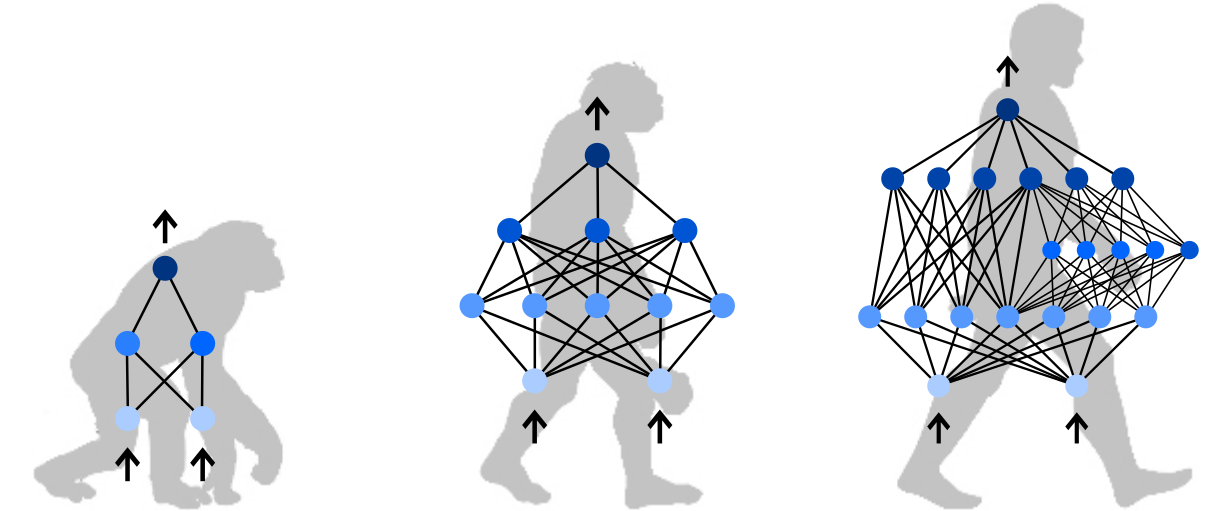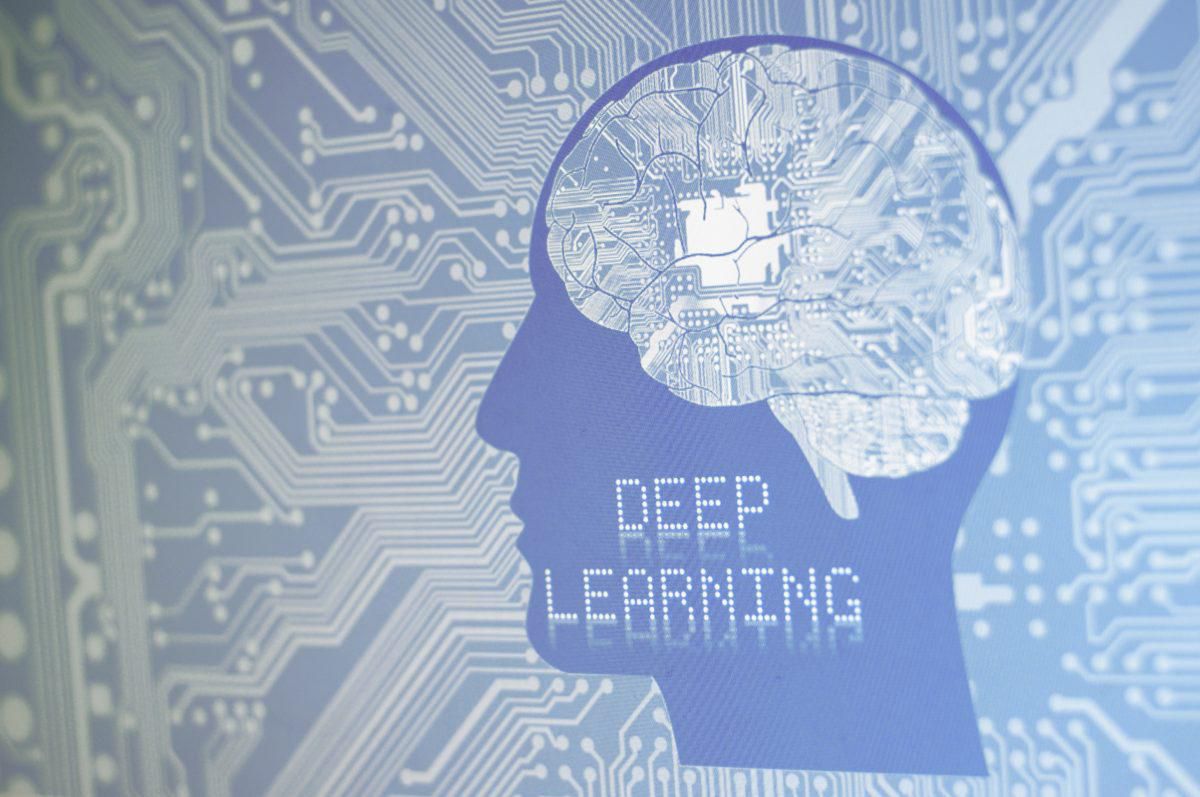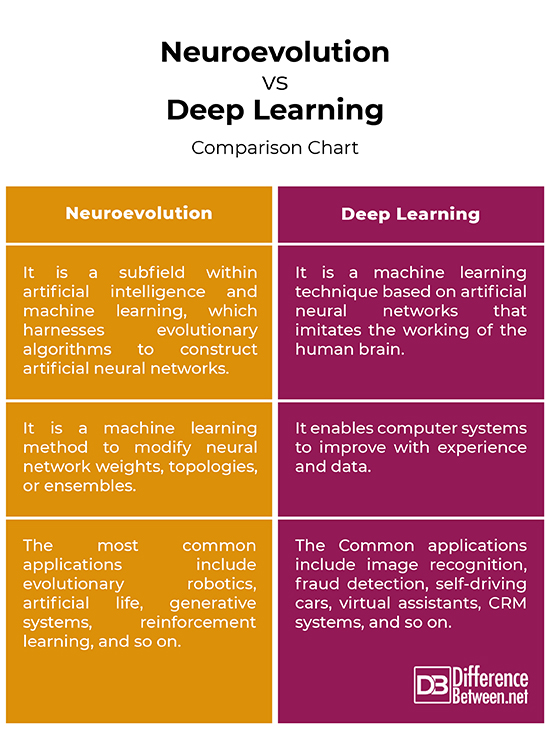Difference Between Neuroevolution and Deep Learning
One of the most striving and long standing goals within the field of computational intelligence is to create intelligent, self aware machines that can mimic or even surpass human intelligence. An intelligent machine can learn, improve on itself, and then make its own path forward. We have come a long way from the good old fashioned AI systems of the 1950s to the modern day artificial neurocomputation. Today these intelligent systems can do all kinds of stuff such as analyze images, control an Unmanned Aerial Vehicle (UAV), drive your car, and become your virtual assistant. Today’s most advanced approaches to computational intelligence are through neuroevolution, an evolutionary approach to Deep Learning inspired by the human brain.

What is Neuroevolution?
Neuroevolution or neuro-evolution is a subfield within artificial intelligence and machine learning, which harnesses evolutionary algorithms to construct artificial neural networks. Neuroevolution is an evolutionary approach to deep learning networks that has been successfully applied in the domain of artificial life, generative systems, robot control, and computer games. It describes an evolutionary process similar to the one that made our brains, except inside a computer. In fact, the whole concept was inspired by the structure of human brain. It was strongly believed that if the human brain could be replicated in some way, it would create artificial intelligence. The term artificial neural networks represent a graph of nodes connected by links with each link carrying a particular weight. The nodes remotely resemble the way the neurons in human brain are organized. Today’s most advanced approaches to computational intelligence are through neuroevolution. The concept has been extensively used in the games domain.

What is Deep Learning?
Deep Learning is a machine learning technique based on artificial neural networks that imitates the working of the human brain. Let’s take the example of Google Translate – it translates paragraphs of texts or entire page from one language to another in seconds. So, you can say Google Translate is based on the concept of Deep Learning and artificial neural networks (ANNs). ANNs are a bio-inspired approach to computational intelligence and machine learning. It uses multiple layers to extract high-level features from the raw sensory input data. It enables computer systems to improve with experience and data. It is a particular kind of machine learning technique to create AI systems that can function in complicated real-world environments. Deep Learning represents the world as a nested hierarchy of concepts where each concept is defined in relation to simpler concepts, and the more abstract representations computed in terms of less abstract ones.
Difference between Neuroevolution and Deep Learning
Concept
– Deep Learning is a technique of machine learning which is a subset of AI and is designed to mimic the working of the human brain in regards to data processing for use in speech recognition, object detection, language translation, and decision making. It is an AI function based on artificial neural networks, a bio-inspired approach to computational intelligence and machine learning. Neuroevolution, on the other hand, is a form of AI and machine learning that harnesses evolutionary algorithms to construct artificial neural networks. It is an evolutionary approach to deep learning networks that intends to simplify the process of solving complex tasks.
Working
– Deep Learning represents the world as a nested hierarchy of concepts where each concept is defined in relation to simpler concepts, and the more abstract representations computed in terms of less abstract ones. It enables computer systems to improve with experience and data similar to how human brain processes information in the form of pictures, text or sound. The whole concept of neuroevolution was inspired by the structure of human brain – it constructs artificial neural networks using evolutionary algorithms. There are two approaches to neuroevolution, ones that consider the evolution of a network’s connection weights only and those that evolve both the connection weights and the network topology.
Applications
– Neuroevolution has been extensively used in the games domain in roles such as evaluating the state-action space of a game, modeling opponent strategies, modeling player experience, and so on. The most common applications include evolutionary robotics, artificial life, generative systems, reinforcement learning, etc. Deep learning uses huge neural networks to understand complex patterns in large amounts of data. Common applications include image recognition, fraud detection, self-driving cars, virtual assistants, bots, CRM systems, natural language processing, industrial pharmaceutical research, supercomputing, and so on.
Neuroevolution vs. Deep Learning: Comparison Chart

Summary
Both neuroevolution and deep learning are highly distributed and concurrent problem solving approaches that are crucial in the success or failure of most problems and applications. The basic concept behind neuroevolution is to produce the artificial neural networks by using evolutionary algorithms, a population-based metaheuristic optimization algorithm. Genetic operators are the very heart of every evolutionary algorithm, and the performance of any neuroevolutionary algorithm depends on them. An evolutionary algorithm uses mechanisms inspired by biological evolution, such as mutation and crossover. Deep learning is a machine learning technique based on the structure and function of the human brain and uses multiple layers to mine meaningful features from the raw sensory input data.
- Difference Between Caucus and Primary - June 18, 2024
- Difference Between PPO and POS - May 30, 2024
- Difference Between RFID and NFC - May 28, 2024
Search DifferenceBetween.net :
1 Comment
Leave a Response
References :
[0]Yannakakis, Georgios N. and Julian Togelius. Artificial Intelligence and Games. Berlin, Germany: Springer, 2018. Print
[1]Omelianenko, Iaroslav. Hands-On Neuroevolution with Python: Build High-performing Artificial Neural Network Architectures Using Neuroevolution-based Algorithms. Birmingham, United Kingdom: Packt Publishing, 2019. Print
[2]Sher, Gene I. Handbook of Neuroevolution Through Erlang. Berlin, Germany: Springer, 2012. Print
[3]Goodfellow, Ian et al. Deep Learning. Massachusetts, United States: MIT Press, 2016. Print
[4]Image credit: https://thumbor.forbes.com/thumbor/fit-in/1200x0/filters%3Aformat%28jpg%29/https%3A%2F%2Fblogs-images.forbes.com%2Fbernardmarr%2Ffiles%2F2018%2F10%2FAdobeStock_179912599-1-1200x797.jpeg
[5]Image credit: https://miro.medium.com/max/4800/1*Uowkdl_riYAj4ZGtV0EZ1Q.png

I must thank you for the efforts you have put in penning this blog.
I’m hoping to check out the same high-grade content by you in the future as well.
In fact, your creative writing abilities has motivated me to get my own site now 😉